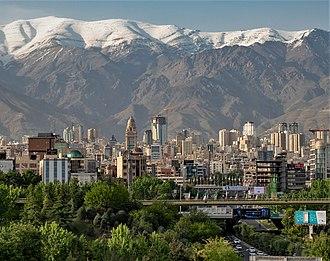Tehran On The Brink: Can Iran Survive Its Water Crisis?
As the Iranian capital grapples with an unprecedented water crisis, the implications are far-reaching, touching not only the environment but also the nation’s socio-economic stability. With reservoirs dwindling and aquifers depleted, Tehran, a bustling metropolis home to over eight million residents, stands at a critical juncture. This article explores the complex interplay of mismanagement, climate change, and population growth that has exacerbated Iran’s water woes. Through the lens of local communities and expert insights, we investigate whether the nation can navigate these daunting challenges or if it risks descending further into a state of crisis. As the water supply dwindles, the stakes have never been higher for Iran’s survival amid growing unrest and the threat of social upheaval.
The Urgency of Water Scarcity in Tehran’s Urban Landscape
The situation in Tehran mirrors a growing concern facing many urban centers: water scarcity is no longer a distant threat but a pressing reality. As the population swells and climate change exacerbates existing challenges, the demand for water continues to outpace supply. Key factors contributing to this crisis include:
- Rapid Urbanization: The city’s expanding footprint increases water demand.
- Mismanagement of Resources: Inefficient water distribution and wastage complicate the situation.
- Changing Climate: Irregular rainfall patterns and increasing temperatures strain reservoirs.
This alarming scarcity undermines countless aspects of daily life. Households face water rationing, posing serious health risks, while agricultural sectors struggle to maintain productivity. The table below illustrates the impact of water scarcity on various sectors:
| Sector | Impact of Water Scarcity |
|---|---|
| Households | Increased conflict over resources and health risks due to poor sanitation. |
| Agriculture | Declining crop yields and food insecurity among urban populations. |
| Industry | Reduced operational capacity and increased production costs. |
Innovative Solutions and International Collaboration to Mitigate Water Crisis
The escalating water crisis in Iran demands not only local solutions but also a robust framework for international collaboration. With many regions facing severe droughts and diminishing water resources, innovative technologies are emerging as a beacon of hope. Countries around the globe are stepping up to share best practices and sustainable strategies. For instance, implementing water-saving irrigation techniques and desalination technologies can provide immediate relief, while long-term projects, such as rainwater harvesting systems, are essential for building resilience against future shortages. Collaborative platforms such as UNESCO’s Global Water Forum are crucial in fostering dialogues and sharing expertise among nations facing similar challenges.
Additionally, financial and technical aid from international organizations can significantly bolster local efforts. Governments and NGOs can work together to establish water management training programs that emphasize the need for efficient usage and preservation of existing resources. To illustrate the benefits of international collaboration, the following table outlines some successful partnerships and their outcomes:
| Collaboration | Key Actions | Outcomes |
|---|---|---|
| Iran-Turkey Water Alliance | Data sharing on water resources | Improved river basin management |
| Germany-Iran Agricultural Exchange | Advanced irrigation training | 30% reduction in water usage |
| UNESCO Program | Capacity-building initiatives | Enhanced community resilience |
The Socio-Political Implications of Iran’s Water Management Challenges
As Iran grapples with severe water management challenges, the political landscape is shifting, revealing the intricate interplay between environmental crises and governance. Water scarcity has emerged as a critical issue, fueling public discontent and eroding trust in the authorities. Many citizens attribute the plight of their dwindling water resources to governmental mismanagement, corruption, and a lack of effective policies. This growing frustration has the potential to mobilize protests, as communities seek accountability and demand action. The regime’s inability to address these pressing concerns could lead to heightened social unrest, undermining its stability and legitimacy.
The socio-political ramifications extend beyond immediate public dissatisfaction. As regions become increasingly arid, competition for water resources may exacerbate existing ethnic and regional tensions. Key factors contributing to this volatile mix include:
- Rural vs. urban population dynamics
- Geographical disparities in resource distribution
- Inadequate infrastructure and outdated irrigation practices
Such divisions risk not only deepening societal fractures but also hindering collaborative efforts for sustainable water management. In this context, international organizations may step in to offer support or guidance, but their involvement could be viewed with suspicion by a government wary of external influence. The outcome will likely depend on the regime’s capacity to harmonize environmental imperatives with political realities, a delicate balance that could shape Iran’s future.
Concluding Remarks
As Iran grapples with a formidable water crisis, the stakes have never been higher for its population and the sustainability of its agriculture, industry, and overall way of life. The situation demands urgent attention from both national leadership and international observers, as water scarcity not only fuels socio-economic tensions but also poses a direct threat to the country’s long-term stability.
The Iranian government has implemented various measures in an attempt to address the crisis, yet the effectiveness of these initiatives remains in question amidst growing public discontent and environmental degradation. As citizens take to the streets to voice their frustrations, the situation may escalate further, prompting a need for a comprehensive and collaborative approach to water management that prioritizes sustainability.
The coming months will be crucial in determining whether Iran can navigate this perilous period, as both policymakers and the populace must engage in a vital dialogue about water use, conservation, and equitable distribution. The choices made today will resonate for years to come, shaping not only the future of Iran’s environment but also the hopes of millions who call this nation home. As the country stands on the brink, the world watches closely, aware that the resolutions forged in this crisis may well define a new chapter in Iran’s storied history.
